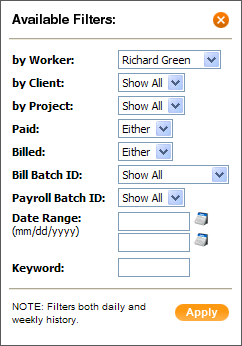Truly one of the most powerful features throughout the EnterYourHours.com System is the ability to filter, search and sort. Filtering, searching, and sorting on the Expenses tab is similar to filtering, searching, and sorting on any other tab.
Sorting Your Expenses
To sort, click on the header for any of the following fields: Date, Client, Project, Worker, Description, Amount. The first time you click on a header, the list will be sorted in ascending alphabetical order (A->Z) based on the column you clicked, and the second time you click the same column, the list will sort in descending order. Every time thereafter, will toggle between the two.
If you are changing sorts between multiple columns, keep in mind that clicking on another column will reset all other columns to sort ascending the next time they are clicked.]
Filtering and Searching Your Expenses
Filtering and searching is really the same thing, but it might help to think of each separately. Both are accomplished via the Filter form by clicking the Filter button on the History toolbar:
Filter Button on the History Toolbar:
 Filter
Filter Filter Form:

Keep in mind that the filter will affect the results of all the tabs (Hours, Expenses, Adjustments, and Summary)
If you need to find a particular record, you might want to use the Key Word option, or you can input more extensive criteria by using other options in the Filter Form. Also, if you have exceeded the max number of records enabled for display, as set by you or another administrator in Performance Settings, you will need the filter to seek out older records.
You can also think of the Filter as an ad-hoc reporting tool. The Expenses Tab also displays totals at the bottom, so you can use it for summarizing information. For example, perhaps you want to amount of expenses you've reimbursed for a particular client across a certain date range. Or you might want to see the total number of expenses you've entered for a particular project. Whether you are trying to pinpoint a particular record, or view lots of information at once, you will find the Filter Form a very useful tool.
There are many different way to filter your results, but the following options will be useful to filter your own expenses (as opposed to filtering or searching one of your workers' hours; see Filtering/Searching/Sorting Your Worker's Expenses for more information):
Be aware that selecting Show All for one option does not guarantee you that all items from the list will appear, if you apply specific filters for other options. For example, if put in a date range during which you did not do any work for a particular client, than that particular client will not show up in the Expenses Tab, even if you choose "Show All" for clients.
Client
Either choose "Show All", which will include all the clients, or pick a particular client
Project
You will need to select a Client from the drop-down list. Once selected, the Project drop-down box will fill with choices for the projects that client has.
Paid
Depending on how you or other administrators are using the system (e.g. whether or not you or they are using the Payroll tab), this option will generally control whether you see Expenses that have been reimbursed (choose Yes), not reimbursed (choose No), or either. By choosing Either the EnterYourHours.com System will not filter on payment status at all.
Billed
The Billed option is similar to the Paid option but uses the billing status to determine which records are shown. This option will depend on how you or other administrators are using the system (e.g. whether or not you or they are using the Billing tab), and will generally control whether you see expenses that have been billed (choose Yes), not billed (choose No), or either. By choosing Either the EnterYourHours.com System will not filter on billing status at all.
Date Range
The Date Range option allows you to enter a beginning date, an ending date, or both a beginning and end date. If you only enter a beginning date, it will show expenses beginning from that date, without limiting the end date. If you only put in an end date, it will show the expenses up until that date without limiting the beginning date. This option applies to the date of the expense, not the date that the expense was entered.
Keyword
The keyword option allows you to do a wildcard search on the expense descriptions. If the word or phrase you enter is found anywhere in the expense description, that record will be included with the results.